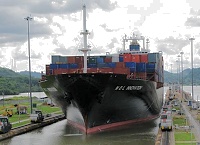Historically, the U.S. East Coast (Atlantic region), led by New York, dominated trading activities with other nations. This makes sense as most of the trade those days was between Europe and the United States. With the emergence of the Asia-Pacific region (first with Japan and now China and the East Asian Tigers) the U.S. West Coast (Pacific region), led by Los Angeles and Long Beach, grew in importance. This certainly had an impact on the local economy in terms of growth in related industries such as shipping, trucking, railroad, and other such industries which resulted in the growth of marine engine oils, railroad engine oils, and HDMOs.
We may now see a shift in trade on a similar scale, with the U.S. Gulf Coast, led by Houston, New Orleans, and other ports in the region being the beneficiaries. A potential game changer, as announced by the Wall Street Journal, is the $5.25 billion widening of the Panama Canal scheduled to be completed in 2014. The widened canal will allow the passage of ships carrying twice the cargo as they are able to carry currently. This should open the Gulf Coast to megaships coming in from Pacific ports such as Singapore, Shanghai, Pusan, and others which have traditionally sent their cargos to the U.S. West Coast. Some leading analysts, according to the Wall Street Journal, predict that more than 25% of this traffic could shift to the Gulf and South Atlantic ports.
In addition, Latin America is now home to many of the world’s fastest growing economies including Brazil, with overall growth rates in 2010 exceeding 6%. Increased shipments are expected to come from Latin America to ports such as Houston, Corpus Christ, Brownsville, New Orleans, Pascagoula, and Gulfport-Biloxi.
The global lubricants market is estimated at around 36 million tonnes in 2010. Latin America now accounts for about 7% of the total. Due to the significant growth predicted over the next decade, this region is expected to increase its appetite for lubricants, with marine engine oils playing an important role as a contributor to this growth in demand. This is expected to have a positive impact on the demand for baseoils, lubricant additives, and finished lubricants.
This shift in trade patterns will have an impact on where lubricants are consumed. As per the recently published Kline study, Opportunities in Lubricants, North America, Petroleum Administrative for Defence District (PADD) 3 accounts for 16% of all lubricants consumed in the United States in 2010. Based on all of the changes highlighted above, we expect this number to grow significantly over the next decade.
What impact will these developments have on the supply chains of various participants in the lubricants industry? Would the sales force, technical support, and blend plant locations need to be re-aligned? Astute marketers will be well served to stay on top of these developments, which could have a significant impact on the U.S. lubricants business. Kline will investigate this issue in a FlashPoint report, The Widening of the Panama Canal: Impact on the Lubricants Industry. Please click here if you are interested in this analysis.
Geeta Agashe, VP, Energy

